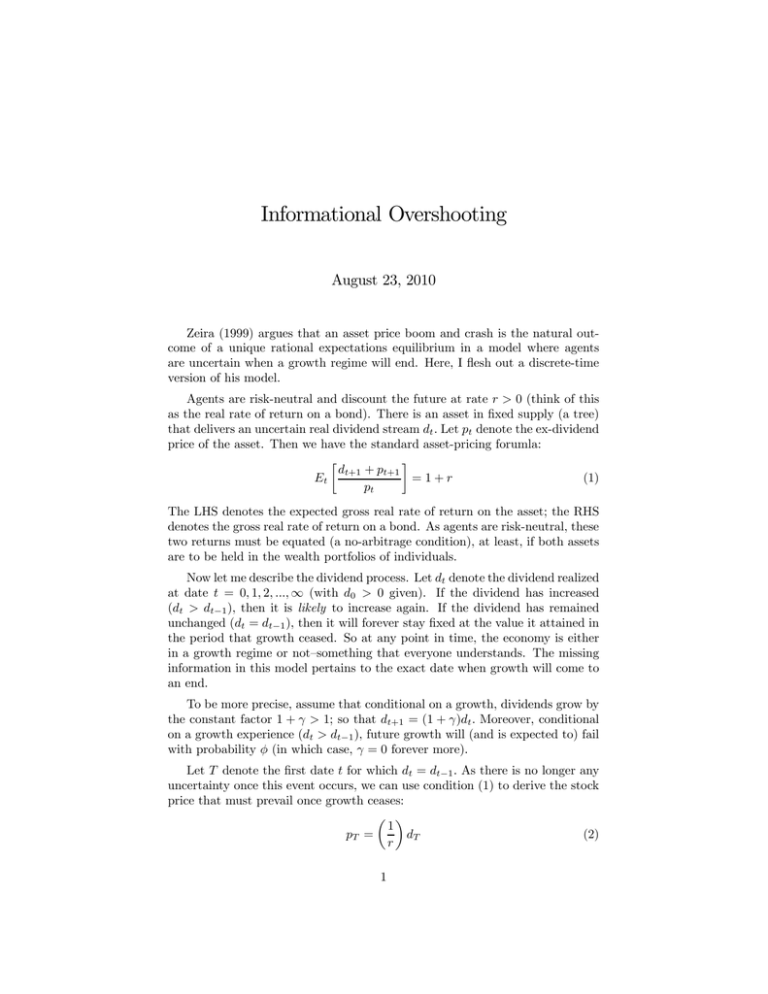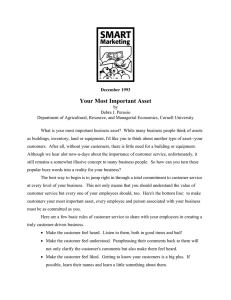Informational Overshooting August 23, 2010
advertisement

Informational Overshooting August 23, 2010 Zeira (1999) argues that an asset price boom and crash is the natural outcome of a unique rational expectations equilibrium in a model where agents are uncertain when a growth regime will end. Here, I flesh out a discrete-time version of his model. Agents are risk-neutral and discount the future at rate 0 (think of this as the real rate of return on a bond). There is an asset in fixed supply (a tree) that delivers an uncertain real dividend stream Let denote the ex-dividend price of the asset. Then we have the standard asset-pricing forumla: ∙ ¸ +1 + +1 =1+ (1) The LHS denotes the expected gross real rate of return on the asset; the RHS denotes the gross real rate of return on a bond. As agents are risk-neutral, these two returns must be equated (a no-arbitrage condition), at least, if both assets are to be held in the wealth portfolios of individuals. Now let me describe the dividend process. Let denote the dividend realized at date = 0 1 2 ∞ (with 0 0 given). If the dividend has increased ( −1 ) then it is likely to increase again. If the dividend has remained unchanged ( = −1 ) then it will forever stay fixed at the value it attained in the period that growth ceased. So at any point in time, the economy is either in a growth regime or not—something that everyone understands. The missing information in this model pertains to the exact date when growth will come to an end. To be more precise, assume that conditional on a growth, dividends grow by the constant factor 1 + 1; so that +1 = (1 + ) Moreover, conditional on a growth experience ( −1 ) future growth will (and is expected to) fail with probability (in which case, = 0 forever more). Let denote the first date for which = −1 As there is no longer any uncertainty once this event occurs, we can use condition (1) to derive the stock price that must prevail once growth ceases: µ ¶ 1 = (2) 1 for all ≥ This is the long-run fundamental price of the asset. The question is whether the equilibrium price may overshoot this long-run fundamental price. If so, the price dynamics will, ex post, have resembled an asset price bubble.1 For dates condition (1) implies (1 − ) [(1 + ) + +1 ] + [ + ] = (1 + ) I conjecture an asset price function in the form of = ( ) From the asset-pricing equation above, this implies (1 − ) [(1 + ) + ((1 + ))] + [ + ] = (1 + )() I am guessing that there is a number (likely 1 + , but let me check) satisfying ((1 + )) = () If so, then (1 − ) [(1 + ) + ()] + [ + ] = (1 + )() Now solve for () (conditional on ), (1 − )(1 + ) + (1 − )() + [ + ] = (1 + )() [1 + − (1 − )] () = [(1 − )(1 + ) + (1 + )] So, () = This implies that ((1 + )) = [(1 − )(1 + ) + (1 + )] [1 + − (1 − )] [(1 − )(1 + ) + (1 + )] (1 + ) [1 + − (1 − )] Setting ((1 + )) = () and solving for yields (as expected) = 1 + And so, if the end has not been reached, the equilibrium asset price is given by () = Ω where Ω= (3) (1 − )(1 + ) + (1 + ) 1 + − (1 − )(1 + ) We should check to see what happens if = 0 (the dividend is expected to grow forever at rate ). In this case, our formula suggests ∙ ¸ (1 + ) () = − 1 (Note: when bubbles break in the data, do asset prices end up higher, lower, or at same place as before? I would argue higher, lending support to this hypothesis over, say, a selffulfilling bubble, which places little or no restriction on where you go following a bust.) 2 which is nonsense, unless the dividend grows slower than the rate of interest. Of course, if = 0 then we get the standard result. In general, we have to impose the following condition: 1 + (1 − )(1 + ) (4) Note that this price is proportional to the long-run fundamental price (assuming growth was to stop). I suspect, however, that () That is, the price will be capitalizing some expected growth (even if it does not materialize, ex post). For this to be true, the following must hold (Ω 1) : (1 − )(1 + ) + (1 + ) (1 − )(1 + ) (1 − )(1 + ) (1 − )(1 + ) (1 + ) 1 1 + − (1 − )(1 + ) 1 + − (1 + ) − (1 − )(1 + ) (1 + )(1 − ) − (1 − )(1 + ) ( − )(1 − ) ( − ) i n d e p e n d e n t o f f a i l u r e r a t e ? −1 t r i v i a l l y s a t i s fi e d ? So along an equilibrium trajectory, the asset price is growing at rate 1 At any point in time, it is “over-valued” relative to a “flat” dividend profile by the factor Ω For the period in which growth ceases, the asset price “collapses” by the factor Ω to its (now) long-run fundamental value. Let me assign some numbers, let’s say, for annual data. Let = 005 = 006 and = 13 Ω= (23)(106)(005) + (13) (105) = 112 105 − (23)106 That is, consider an asset that is growing one percent faster than the economy. On the day grow ceases (it is now growing five percent slower than the economy), its price drops by 12%. How about = 010 and 105 − (1 − )11 = 0 Set = 0001 so that = 004637 In this case, Ω= (09537)(11)(005) + (04637) (105) 01011 = = 100+ 00010 So here, a very high rate of return with low probability of ending. The price collapse will be huge. 3




